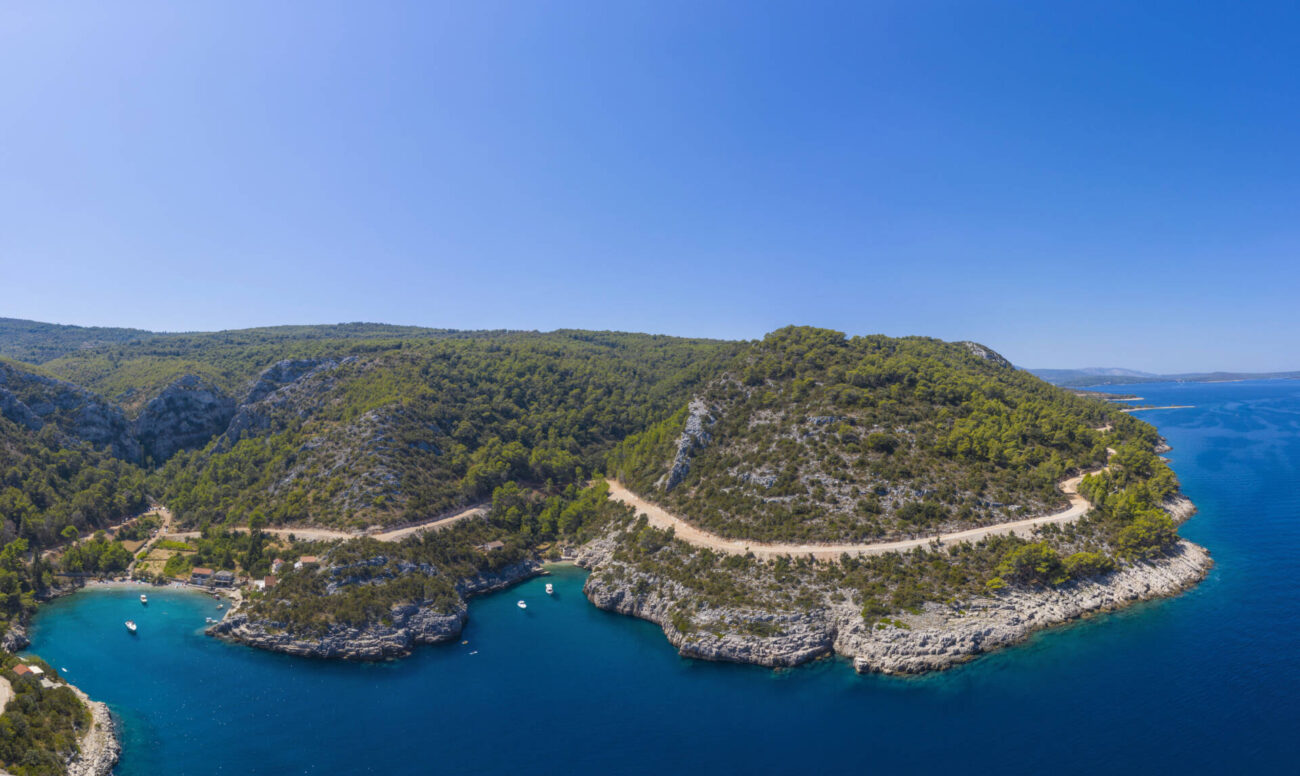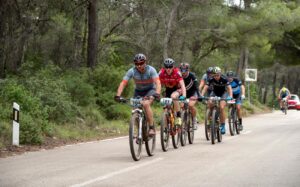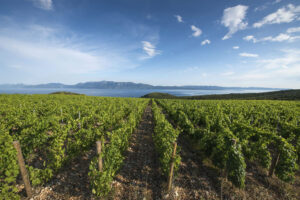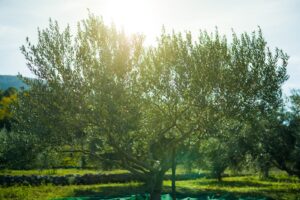
Do You Love Running?
It has become trendy to go for a run through the beautiful sights of nature, for serious athletes and general fitness lovers alike. Jelsa and its surrounds are the ideal setting for combining appreciating nature with maintaining or improving your fitness through running.
If you follow the coast across the Jelsa region and elsewhere around Hvar Island, there are no steep inclines, and the wonderful sea views and beautiful natural environment make this an excellent activity for all age groups. Every sporting activity is easier and more enjoyable in natural surroundings.
Be safe: make sure you have appropriate clothing and running shoes. Preferably, carry extra layers of clothing with you, in case the weather changes, and for when you stop, to avoid getting chilled. Above all, wherever you go running, please remember to carry plain drinking water and a mobile phone as essentials!
• The Prapatna Sea Route
This starts from the Toma Gamulin Square, which is in the heart of Jelsa, just north of the park, and boasts a splendid ornamental fountain. The route heads east, past Jelsa’s Pjaca, called the Square of Croatian National Revival, which dates from the 16th century, and has a drinking fountain in the middle, which was built in 1934. Going straight on, you pass several restaurants and cafes, and yachts at their moorings, which will give you a sense of the charm of Jelsa and its inhabitants.
At the end of the town’s waterfront is the ‘Kanun’ lighthouse, built in 1868. The asphalt road leads straight on through the pine trees past the Mina, Grebišće and Zenčišće beaches, and you will savour the heady scent of the sea and a welcome the light cooling breeze. About 500 metres on from the Zenčišće Beach you turn on to the macadam path which follows the seashore. This takes you to a bay called ‘Crikvica’ or ‘Carkvica’, which means ‘chapel’, and was so named because of the exquisite little Chapel of St. Luke which sits close to the sea on the promontory of the bay. This little landmark confirms that you are on the right track.
After this bay, a macadam path along the coast extends for some 3 km up to the Prapatna Bay. There is a slight incline in easy stages, so the route is benign even for beginner runners. Once you get to Prapatna, with its enticing blue-green sea, you deserve a rest and a swim.
If you want to make the run more testing, head north from Prapatna up to the main road, where you turn right to go back to Jelsa. The road is hilly, so this is only recommended for the very fit.
• The Unesco “Za križen” Route
Everyone who knows and loves Hvar has certainly heard of the people’s procession called “Za Križen”, which means “Following the Cross”. This tradition has taken place annually over about 500 years through the night of Maundy Thursday, and was entered into the UNESCO Intangible Cultural Heritage List in 2009. It is a pilgrimage around the churches in six places, Jelsa, Pitve, Vrisnik, Svirče, Vrbanj and Vrboska, to pay homage to Christ’s tomb, which is symbolically represented in each venue. In the normal way, anyone can join in the Maundy Thursday Procession (2020 was an exception, with participants limited because of Covid-19). Taking part in the procession is an uplifting spiritual experience when approached in the right frame of mind, with an appropriate level of physical fitness. Outside of this event, the 22 km or so covered by the Procession route are perfect as a longer-distance run, also for hikers. It’s also a good bike ride, but of course cyclists can’t ride right up to the churches.
To follow the Procession route, you can set out from the main church in whichever place you choose, and then head in a clockwise direction towards the next settlement, in the order given above. The details of the route can vary, as each village has its own traditions, and Cross-bearers have a certain latitude of choice. For instance, some Cross-bearers head up to the Our Lady of Health Church above Jelsa and then on to Pitve, whereas others leave Jelsa and take a direct route to Pitve; some keep to the road between Jelsa and Pitve, passing through both parts of Pitve Village, while others turn left at the big conifer on the Pitve road to use the old path through the fields up into Gornje Pitve, by-passing Donje Pitve. To keep to the Procession tradition, when you arrive at the next village, you should run or walk clockwise round the main church before proceeding.
The “Za Križen” procession route offers you a unique chance to experience much of Hvar’s beauty in its historic settlements, fields, countryside and seaboard, all in scenic succession. You should plan the exact details of your route before setting off, and make sure you have fresh drinking water with you, also a mobile phone in case you run into trouble!
• The Scenic Route
This route, from Jelsa to the village of Humac and on up to St. Anthony’s hilltop is a challenge for the fittest runner! From Jelsa to Humac you will be running uphill on asphalt for 7 km. Humac is a magical historic dormitory village, which was entered into the Cultural Heritage Register in 1976. The beautiful environment and fresh air will recharge your batteries as you run through it.
This wonderfully preserved village was founded in the 17th century, and has retained its rural architectural style of stone houses and paved paths, giving you a sense of how people lived and worked in forgotten times past. This is a rare example in which past times have been lovingly preserved, and every stone tells its own story. Try to imagine how much each stone under your feet as you run has to tell you about its past.
Leaving Humac, you turn towards the west of Hvar, to head towards the hilltop of St. Anthony, which is 5 km away via a macadam road. Innumerable fragrant herbal plants will line your route, and you may be lucky enough to meet horses, all of them tame. They are used to people, and will probably approach you, expecting some food treat like an apple or carrot. Slow down, or stop, but ignore them if you don’t want them to follow you!
At the top of a rise overlooking the little village of Zavala on the south side of Hvar is a tine shrine dedicated to St. Anthony. The view from this peak is breathtaking: the panorama stretches from the Isle of Šćedro over to the islands of Korčula and Vis, and the Pelješac Peninsula. The whole vista looking as though you can hold them in the palm of your hand. You leave the peak on the northern side, to come down to the charming little village of Gornje Pitve. From the village you take the old path which leads through the vineyards and olive groves to join the road down to Jelsa.
This run will give you an idea of just how full of treasures Hvar Island is, beyond just being a destination of sun and sea.
• The UNESCO Starigrad Plain Route
The Stari Grad Plain is a historic preserved layout of parcelized fields and drystone walling which dates back to Antique times and was entered into the UNESCO World Heritage List in 2008. It is the best preserved example of this kind of ancient agricultural layout in the Mediterranean, and is the biggest fertile plain on the Dalmatian islands.
You can start your run from Jelsa, leaving the town on the main road towards Stari Grad. Turn right off the road, heading towards Vrboska, then left at the first crossroads, which will take you on to the Plain. Alternatively, if you start from Vrboska, turn right on to that road, before you reach the main road. The side road takes you past a little airstrip, which serves small emergency aircraft and private planes, and becomes macadam. Stay on it, heading west, to reach Stari Grad, founded in 384 BCE, and reputedly the oldest town in Croatia. Its charming little alleyways were immortalized by the Renaissance poet Petar Hektorović (1487 -1572). Having seen a little of Stari Grad, you turn east out of the town on the main road, and head up towards Dol, turning right at the crossroads signposted to that village. After Dol, the old road takes you to Vrbanj, which was once a thriving centre for the central part of Hvar Island. It was the home of Matij Ivanić (d. 1523), revolutionary leader of a people’s uprising on Hvar which took place between 1510 and 1514. Now his little house is just a sad ruin in between more picturesque, often renovated stone cottages. The road takes you past Vrbanj’s Church of the Holy Spirit, and then you head on towards Jelsa, passing the turning for the village of Svirče which will be on your right.









